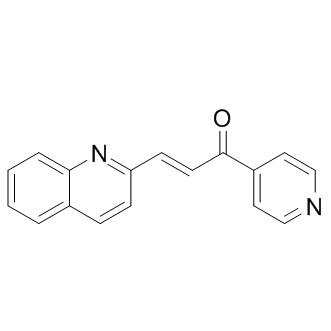| Cas No.: | 4382-63-2 |
| Chemical Name: | (E)-3-(pyridin-3-yl)-1-(quinolin-3-yl)prop-2-en-1-one |
| Synonyms: | PFK015,PFK15,PFK 15,PFK-15 |
| SMILES: | C1=CN=CC=C1C(=O)/C=C/C1=CC=C2C=CC=CC2=N1 |
| Formula: | C17H12N2O |
| M.Wt: | 260.29 |
| Sotrage: | 2 years -20°C Powder, 2 weeks 4°C in DMSO, 6 months -80°C in DMSO |
| Description: | PFK-015 is an effective inhibitor of PFKFB3 with IC50 of 110 nM (recombinant PFKFB3) and inhibits PFKFB3 activity in cancer cells with IC50 of 20 nM.PFK-015 possesses compelling in vitro properties, has satisfactory PK properties in rodents, and suppresses tumor glucose metabolism and growth in an aggressive mouse model of non-small cell lung cancer. PFK-015 is not a Pgp substrate as determined by transport and cell permeability assays in Caco-2 and MDCK-MDR1 (Papp A-B / B-A results 1.8 / 4 and 5 / 5 10–6 cm/s). PFK-015 inhibits cancer cell proliferation in a panel of 17 cancer cell lines. PFK-015 suppresses glucose uptake in cancer cells. Rodent PK studies following IV dosing at 5 mg/kg resulted in a profile with a satisfactory half-life (5.1 hours), exposure (AUCinf 1804 ng.h/ml), tissue distribution (Vd 20.5 L/kg) and reasonable clearance (46.2 mL/min/kg). Also, pre-clinical efficacy studies of C57Bl/6 mice bearing Lewis Lung Carcinoma (LLC) xenografts demonstrated 80% tumor growth inhibition relative to vehicle control. Finally, micro-PET studies performed on mice bearing LLC tumors showed a significant inhibition of tumor 2-[18F]-fluoro-2-deoxy-glucose uptake. These results support further development of PFK-015 as a novel anti-cancer agent. |

 DC Chemicals' products qualify for U.S. tariff exemptions. We guarantee no price increases due to customs duties and maintain stable supply, continuing to deliver reliable research solutions to our American clients.
DC Chemicals' products qualify for U.S. tariff exemptions. We guarantee no price increases due to customs duties and maintain stable supply, continuing to deliver reliable research solutions to our American clients.





















